long Citroen JUMPY 2016 2.G Owner's Guide
[x] Cancel search | Manufacturer: CITROEN, Model Year: 2016, Model line: JUMPY, Model: Citroen JUMPY 2016 2.GPages: 595, PDF Size: 12.47 MB
Page 173 of 595
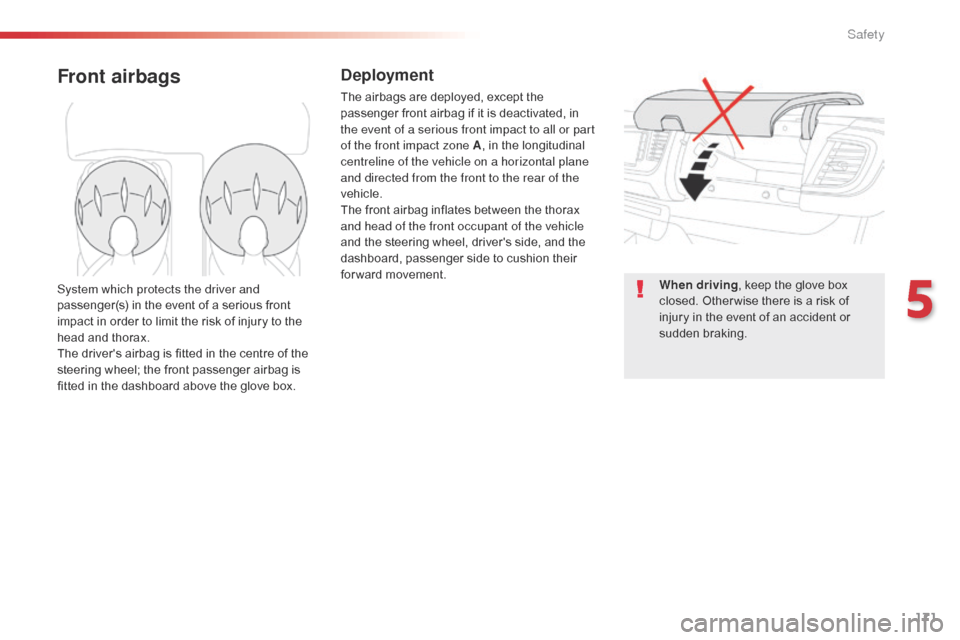
171
Jumpy _en_Chap05_securite_ed01-2016
Front airbagsDeployment
The airbags are deployed, except the
passenger front airbag if it is deactivated, in
the event of a serious front impact to all or part
of the front impact zone A, in the longitudinal
centreline of the vehicle on a horizontal plane
and directed from the front to the rear of the
vehicle.
The front airbag inflates between the thorax
and head of the front occupant of the vehicle
and the steering wheel, driver's side, and the
dashboard, passenger side to cushion their
for ward movement.
System which protects the driver and
passenger(s) in the event of a serious front
impact in order to limit the risk of injury to the
head and thorax.
The driver's airbag is fitted in the centre of the
steering wheel; the front passenger airbag is
fitted in the dashboard above the glove box. When driving
, keep the glove box
closed. Other wise there is a risk of
injury in the event of an accident or
sudden braking.
5
Safety
Page 174 of 595
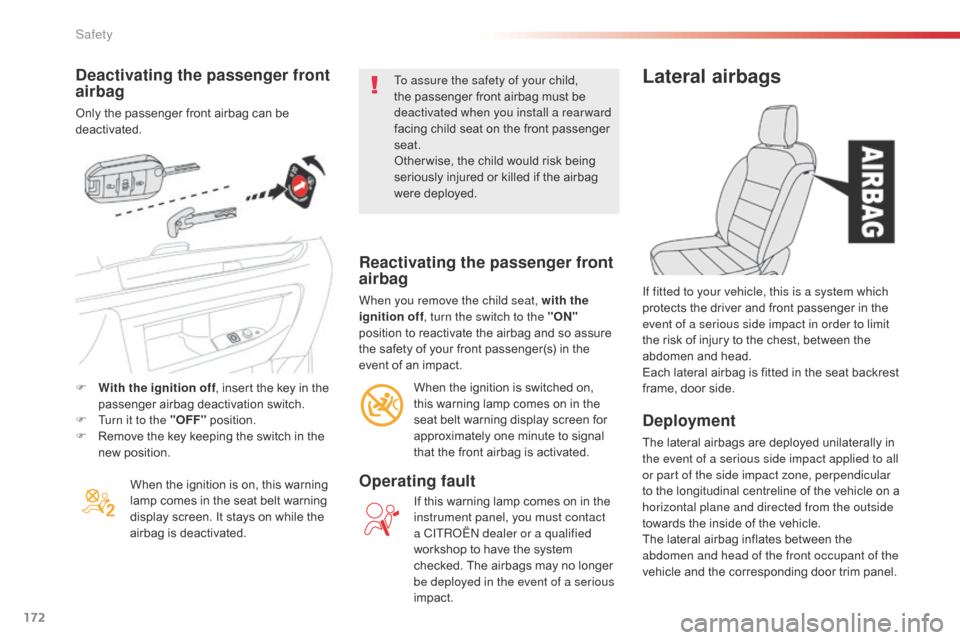
172
Jumpy _en_Chap05_securite_ed01-2016
Deactivating the passenger front
airbag
Only the passenger front airbag can be
deactivated.When the ignition is on, this warning
lamp comes in the seat belt warning
display screen. It stays on while the
airbag is deactivated. To assure the safety of your child,
the passenger front airbag must be
deactivated when you install a rear ward
facing child seat on the front passenger
seat.
Other wise, the child would risk being
seriously injured or killed if the airbag
were deployed.
Reactivating the passenger front
airbag
When you remove the child seat, with the
ignition off
, turn the switch to the "ON"
position to reactivate the airbag and so assure
the safety of your front passenger(s) in the
event of an impact.
When the ignition is switched on,
this warning lamp comes on in the
seat belt warning display screen for
approximately one minute to signal
that the front airbag is activated.
Operating fault
If this warning lamp comes on in the
instrument panel, you must contact
a CITROËN dealer or a qualified
workshop to have the system
checked. The airbags may no longer
be deployed in the event of a serious
impact.
Lateral airbags
Deployment
The lateral airbags are deployed unilaterally in
the event of a serious side impact applied to all
or part of the side impact zone, perpendicular
to the longitudinal centreline of the vehicle on a
horizontal plane and directed from the outside
towards the inside of the vehicle.
The lateral airbag inflates between the
abdomen and head of the front occupant of the
vehicle and the corresponding door trim panel. If fitted to your vehicle, this is a system which
protects the driver and front passenger in the
event of a serious side impact in order to limit
the risk of injury to the chest, between the
abdomen and head.
Each lateral airbag is fitted in the seat backrest
frame, door side.
F
W
ith the ignition off
, insert the key in the
passenger airbag deactivation switch.
F
T
urn it to the "OFF"
position.
F
R
emove the key keeping the switch in the
new position.
Safety
Page 198 of 595
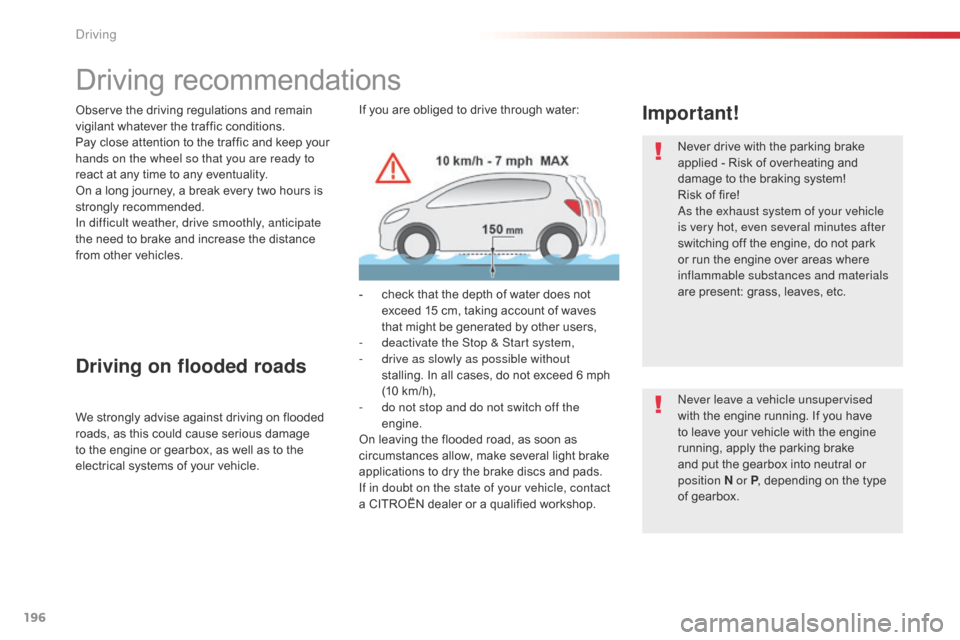
196
Jumpy _en_Chap06_conduite_ed01-2016
Driving recommendations
Observe the driving regulations and remain
vigilant whatever the traffic conditions.
Pay close attention to the traffic and keep your
hands on the wheel so that you are ready to
react at any time to any eventuality.
On a long journey, a break every two hours is
strongly recommended.
In difficult weather, drive smoothly, anticipate
the need to brake and increase the distance
from other vehicles.Never drive with the parking brake
applied - Risk of overheating and
damage to the braking system!
Risk of fire!
As the exhaust system of your vehicle
is very hot, even several minutes after
switching off the engine, do not park
or run the engine over areas where
inflammable substances and materials
are present: grass, leaves, etc.
Never leave a vehicle unsupervised
with the engine running. If you have
to leave your vehicle with the engine
running, apply the parking brake
and put the gearbox into neutral or
position
N or P, depending on the type
of gearbox.
Driving on flooded roads
We strongly advise against driving on flooded
roads, as this could cause serious damage
to the engine or gearbox, as well as to the
electrical systems of your vehicle.
Important!If you are obliged to drive through water:
-
c
heck that the depth of water does not
exceed 15 cm, taking account of waves
that might be generated by other users,
-
d
eactivate the Stop & Start system,
-
d
rive as slowly as possible without
stalling. In all cases, do not exceed 6 mph
(10
km/h),
-
d
o not stop and do not switch off the
engine.
On leaving the flooded road, as soon as
circumstances allow, make several light brake
applications to dry the brake discs and pads.
If in doubt on the state of your vehicle, contact
a CITROËN dealer or a qualified workshop.
Driving
Page 199 of 595
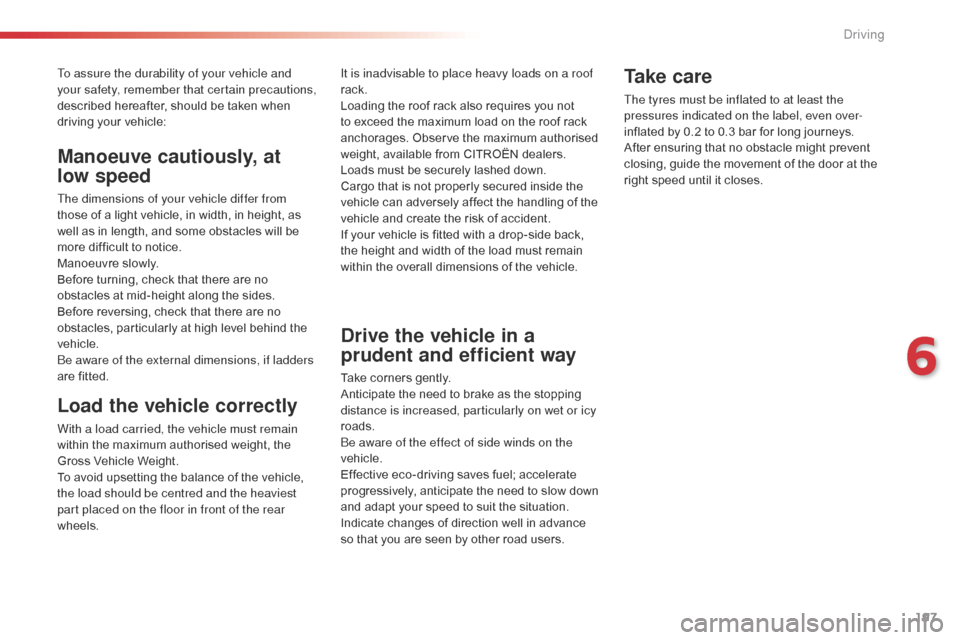
197
Jumpy _en_Chap06_conduite_ed01-2016
To assure the durability of your vehicle and
your safety, remember that certain precautions,
described hereafter, should be taken when
driving your vehicle:
Load the vehicle correctly
With a load carried, the vehicle must remain
within the maximum authorised weight, the
Gross Vehicle Weight.
To avoid upsetting the balance of the vehicle,
the load should be centred and the heaviest
part placed on the floor in front of the rear
wheels.
Manoeuve cautiously, at
low speed
The dimensions of your vehicle differ from
those of a light vehicle, in width, in height, as
well as in length, and some obstacles will be
more difficult to notice.
Manoeuvre slowly.
Before turning, check that there are no
obstacles at mid-height along the sides.
Before reversing, check that there are no
obstacles, particularly at high level behind the
vehicle.
Be aware of the external dimensions, if ladders
are fitted.It is inadvisable to place heavy loads on a roof
rack.
Loading the roof rack also requires you not
to exceed the maximum load on the roof rack
anchorages. Observe the maximum authorised
weight, available from CITROËN dealers.
Loads must be securely lashed down.
Cargo that is not properly secured inside the
vehicle can adversely affect the handling of the
vehicle and create the risk of accident.
If your vehicle is fitted with a drop-side back,
the height and width of the load must remain
within the overall dimensions of the vehicle.
Drive the vehicle in a
prudent and efficient way
Take corners gently.
Anticipate the need to brake as the stopping
distance is increased, particularly on wet or icy
roads.
Be aware of the effect of side winds on the
vehicle.
Effective eco-driving saves fuel; accelerate
progressively, anticipate the need to slow down
and adapt your speed to suit the situation.
Indicate changes of direction well in advance
so that you are seen by other road users.
Take care
The tyres must be inflated to at least the
pressures indicated on the label, even over-
inflated by 0.2 to 0.3 bar for long journeys.
After ensuring that no obstacle might prevent
closing, guide the movement of the door at the
right speed until it closes.
6
Driving
Page 200 of 595
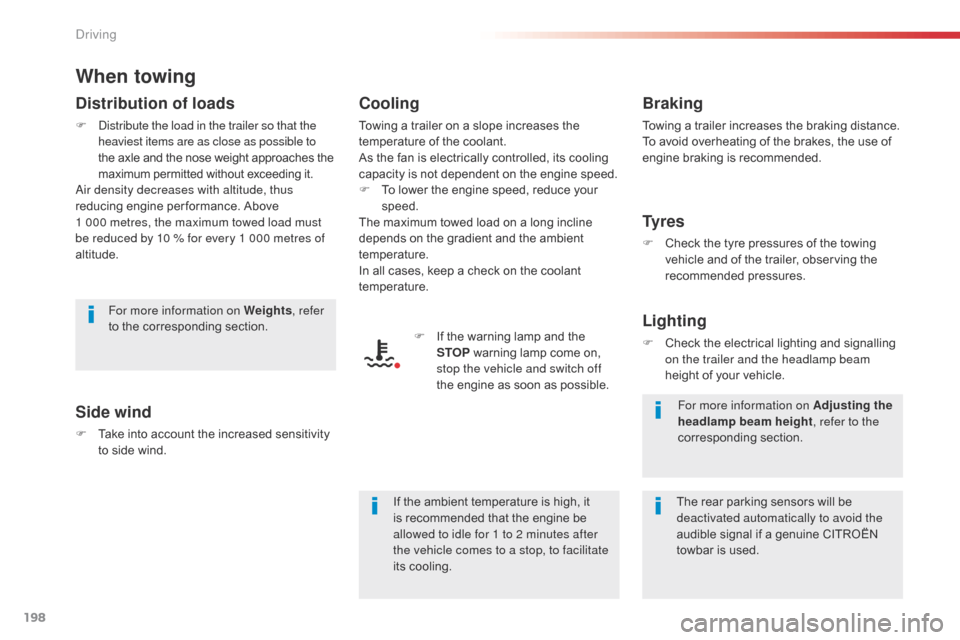
198
Jumpy _en_Chap06_conduite_ed01-2016
When towing
Distribution of loads
F Distribute the load in the trailer so that the heaviest items are as close as possible to
the axle and the nose weight approaches the
maximum permitted without exceeding it.
Air density decreases with altitude, thus
reducing engine per formance. Above
1
000 metres, the maximum towed load must
be reduced by 10
% for every 1 000 metres of
altitude.
Side wind
F Take into account the increased sensitivity to side wind.
Cooling
Towing a trailer on a slope increases the
temperature of the coolant.
As the fan is electrically controlled, its cooling
capacity is not dependent on the engine speed.
F
T
o lower the engine speed, reduce your
speed.
The maximum towed load on a long incline
depends on the gradient and the ambient
temperature.
In all cases, keep a check on the coolant
temperature.
F
I
f the warning lamp and the
STOP warning lamp come on,
stop the vehicle and switch off
the engine as soon as possible.
Braking
Towing a trailer increases the braking distance.
To avoid overheating of the brakes, the use of
engine braking is recommended.
Ty r e s
F Check the tyre pressures of the towing vehicle and of the trailer, observing the
recommended pressures.
Lighting
F Check the electrical lighting and signalling on the trailer and the headlamp beam
height of your vehicle.
For more information on Weights
, refer
to the corresponding section.
The rear parking sensors will be
deactivated automatically to avoid the
audible signal if a genuine CITROËN
towbar is used.
If the ambient temperature is high, it
is recommended that the engine be
allowed to idle for 1 to 2 minutes after
the vehicle comes to a stop, to facilitate
its cooling. For more information on Adjusting the
headlamp beam height
, refer to the
corresponding section.
Driving
Page 202 of 595

200
Jumpy _en_Chap06_conduite_ed01-2016
F Turn the key to position 2, ignition on, to
operate the engine pre-heating.
F
W
ait until this warning lamp
goes off in the instrument panel
then operate the starter motor
by turning the key to position 3
until the engine starts, without
pressing the accelerator. Once
the engine starts, release the key. The warning lamp does not come
on if the engine is already warm.
Depending on the climatic conditions,
it is recommended that you proceed as
follows:
-
I
n temperate conditions, do not
run the engine with the vehicle
stationary to warm it up, but rather
move off straight away and drive at
moderate engine speeds.
-
I
n wintry conditions, the pre-heater
warning lamp will stay on for a
longer period after switching on the
ignition; wait until it goes off before
starting.
-
In ver y severe wintr y
conditions
(
temperature
below
-23°C), to ensure the correct
operation and durability of the
mechanical components of your
vehicle (engine and gearbox), leave
the engine running for 4 minutes
before moving off.
Never leave the engine running in
an enclosed area without adequate
ventilation: internal combustion
engines emit toxic exhaust gases,
such as carbon monoxide. Danger of
intoxication and death. If the engine does not start straight
away, switch off the ignition.
Wait a few moments before trying
again. If the engine does not start after
a few attempts, do not keep trying: you
risk damaging the starter motor and the
engine.
Call on a CITROËN dealer or a qualified
workshop.
Driving
Page 206 of 595
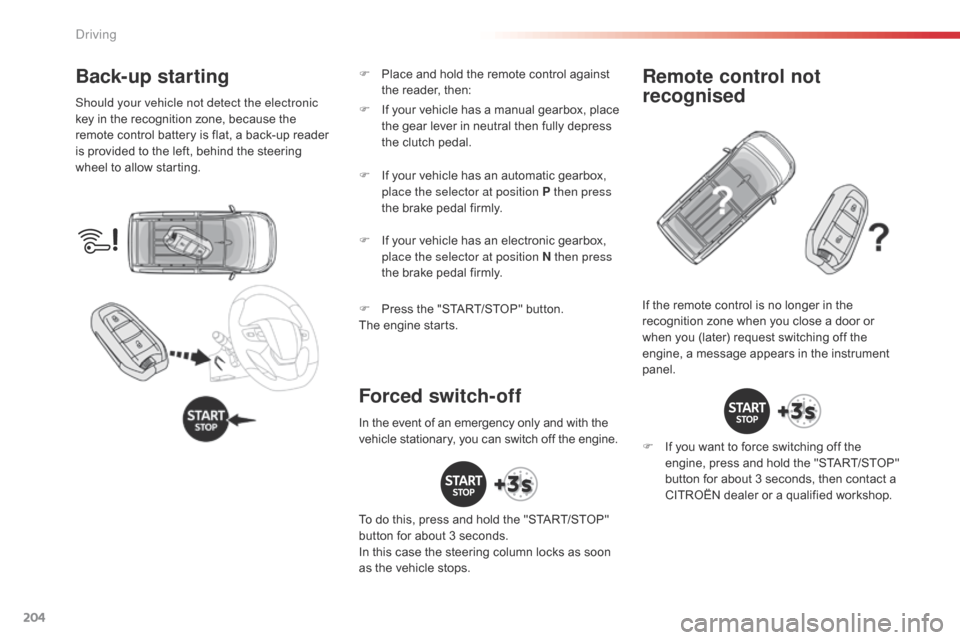
204
Jumpy _en_Chap06_conduite_ed01-2016
Back-up starting
Should your vehicle not detect the electronic
key in the recognition zone, because the
remote control battery is flat, a back-up reader
is provided to the left, behind the steering
wheel to allow starting.F
P
ress the "START/STOP" button.
The engine starts. If the remote control is no longer in the
recognition zone when you close a door or
when you (later) request switching off the
engine, a message appears in the instrument
panel.
Forced switch-offRemote control not
recognised
F If you want to force switching off the
engine, press and hold the "START/STOP"
button for about 3 seconds, then contact a
CITROËN dealer or a qualified workshop.
F
I
f your vehicle has a manual gearbox, place
the gear lever in neutral then fully depress
the clutch pedal.
F
I
f your vehicle has an automatic gearbox,
place the selector at position P then press
the brake pedal firmly.
F
I
f your vehicle has an electronic gearbox,
place the selector at position N then press
the brake pedal firmly.
In the event of an emergency only and with the
vehicle stationary, you can switch off the engine.
To do this, press and hold the "START/STOP"
button for about 3 seconds.
In this case the steering column locks as soon
as the vehicle stops. F
P
lace and hold the remote control against
the reader, then:
Driving
Page 214 of 595
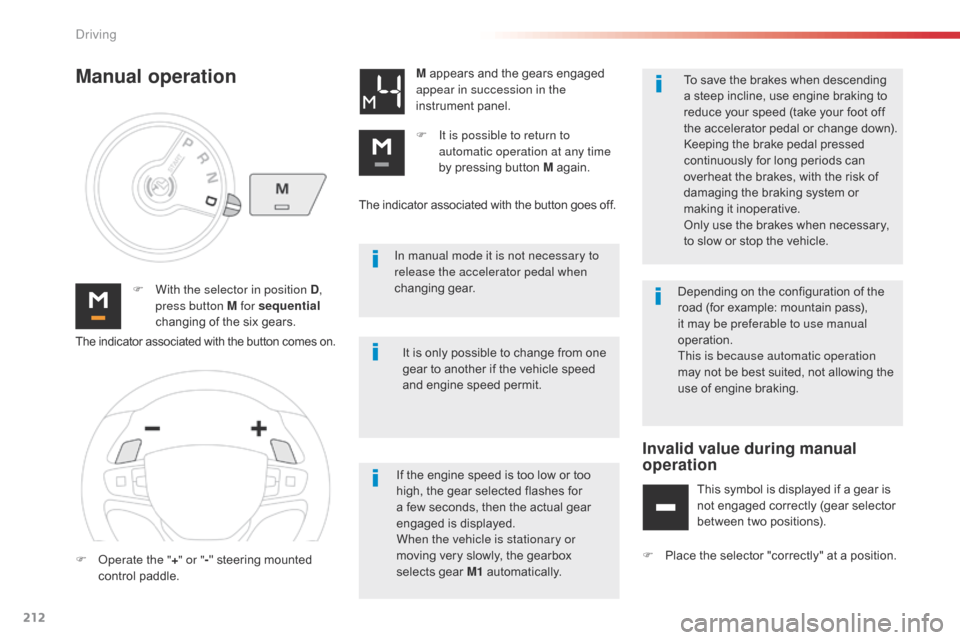
212
Jumpy _en_Chap06_conduite_ed01-2016
In manual mode it is not necessary to
release the accelerator pedal when
changing gear.
F
W
ith the selector in position D ,
press button M for sequential
changing of the six gears. M appears and the gears engaged
appear in succession in the
instrument panel.
F
I
t is possible to return to
automatic operation at any time
by pressing button M again.
It is only possible to change from one
gear to another if the vehicle speed
and engine speed permit.
Manual operation
If the engine speed is too low or too
high, the gear selected flashes for
a few seconds, then the actual gear
engaged is displayed.
When the vehicle is stationary or
moving very slowly, the gearbox
selects gear M1 automatically. To save the brakes when descending
a steep incline, use engine braking to
reduce your speed (take your foot off
the accelerator pedal or change down).
Keeping the brake pedal pressed
continuously for long periods can
overheat the brakes, with the risk of
damaging the braking system or
making it inoperative.
Only use the brakes when necessary,
to slow or stop the vehicle.
The indicator associated with the button comes on.
F
O
perate the " +" or " -" steering mounted
control paddle. The indicator associated with the button goes off.
Depending on the configuration of the
road (for example: mountain pass),
it may be preferable to use manual
operation.
This is because automatic operation
may not be best suited, not allowing the
use of engine braking.
Invalid value during manual
operation
This symbol is displayed if a gear is
not engaged correctly (gear selector
between two positions).
F
P
lace the selector "correctly" at a position.
Driving
Page 215 of 595

213
Jumpy _en_Chap06_conduite_ed01-2016
When the ignition is on, a message
appears in the instrument panel
screen to indicate a gearbox fault.
Operating fault
In this case, the gearbox switches to back-up
mode and is locked in 3rd gear. You may feel
a substantial knock when changing from P
to R and from N to R. This will not cause any
damage to the gearbox.
Do not exceed 60 mph (100 km/h), local speed
restrictions permitting.
Have it checked by a CITROËN dealer or a
qualified workshop. You risk damaging the gearbox:
-
i
f you press the accelerator and
brake pedals at the same time
(braking or acceleration must be
done only with the right foot),
-
i
f you force the selector from
position P to another position when
the battery is flat.
To reduce fuel consumption when
stationary for long periods with the
engine running (traffic jam...), position
the selector at N and apply the parking
brake.
Stopping the vehicle
A stiff point may be noticed when
moving to position P .
If the selector is not in position P ,
when the driver's door is opened or
approximately 45 seconds after the
ignition is switched off, there is an
audible signal and a message appears.
F
R
eturn the selector to position P ;
the audible signal stops and the
message disappears.
Before switching off the engine, select
position
P then apply the parking brake to
immobilise the vehicle. In all circumstances, ensure that the
selector is in position P before leaving
your vehicle. On a steep slope with a loaded
vehicle, press the brake pedal
, select
position
P
, apply the parking brake then
release the brake pedal.
6
Driving
Page 224 of 595
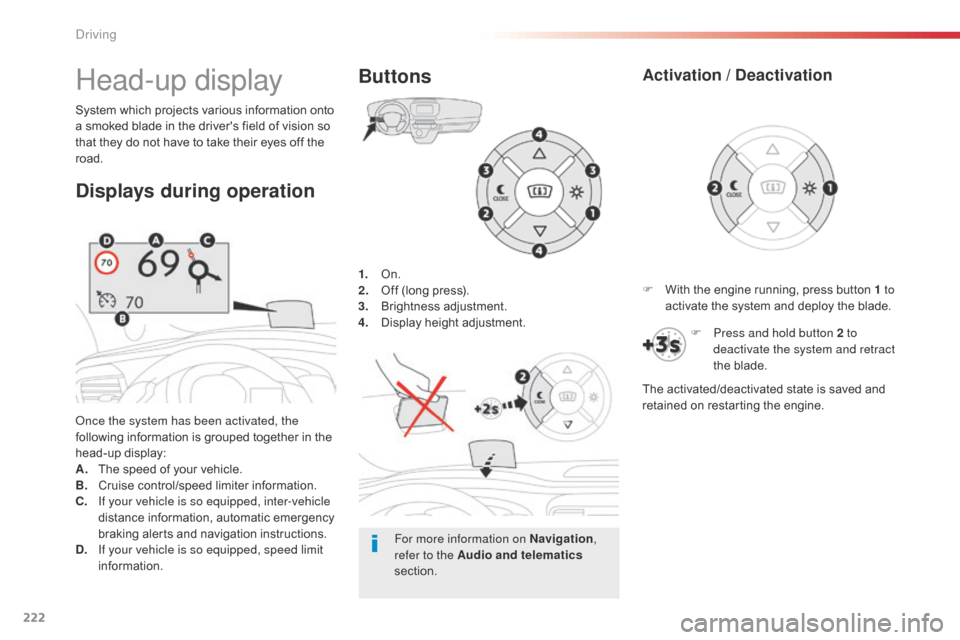
222
Jumpy _en_Chap06_conduite_ed01-2016
1. On.
2. Off (long press).
3.
Br
ightness adjustment.
4.
D
isplay height adjustment.
Once the system has been activated, the
following information is grouped together in the
head-up display:
A.
T
he speed of your vehicle.
B.
C
ruise control/speed limiter information.
C.
I
f your vehicle is so equipped, inter-vehicle
distance information, automatic emergency
braking alerts and navigation instructions.
D.
I
f your vehicle is so equipped, speed limit
information.
System which projects various information onto
a smoked blade in the driver's field of vision so
that they do not have to take their eyes off the
road.
Buttons
Displays during operationHead-up display
For more information on Navigation ,
refer to the Audio and telematics
section. F
W
ith the engine running, press button 1 to
activate the system and deploy the blade.
Activation / Deactivation
F Press and hold button 2 to deactivate the system and retract
the blade.
The activated/deactivated state is saved and
retained on restarting the engine.
Driving